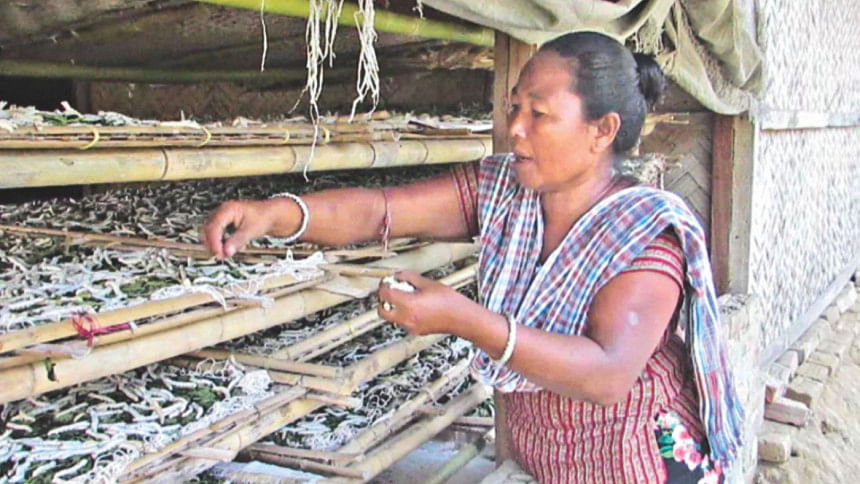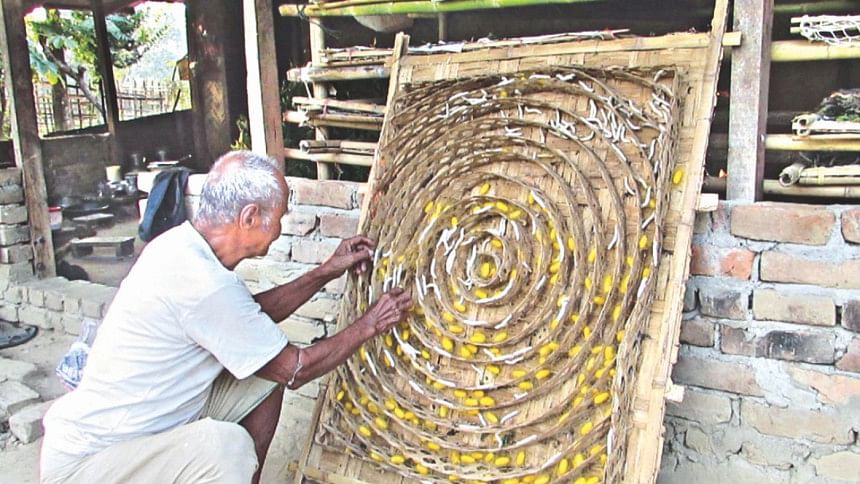Silk industry flourishes in the hills

Several of the peoples of the Chittagong Hill Tracts are famous for weaving. The production of traditional cloth and woven goods, including in silk, is a household custom that dates back centuries. What is new to the region is sericulture: raising silkworms to produce silk thread.
Currently around 828 families across four upazilas in Khagrachhari are trying their hand at sericulture. Of these, 120 have already produced thread, with district-wide silk production amounting to 1,640 kilograms last year. The nascent industry, with a ready market of weavers nearby, holds a lot of promise.
“I grow silk alongside looking after the home,” says Crayori Marma of Beltali Para in Perachara union. “Last year I took 25 days' training from the Bangladesh Sericulture Board. I planted mulberry trees. From the Board I bought silkworms and the equipment one needs. I've been doing well with it. Last season I produced 7.5 kilograms of silk.”
Her neighbour Shantunu Rowaza is following in her footsteps. “We've planted mulberry trees in unused land beside the house,” she says. “I hope we can produce silk from next season.”
As the favourite food of silkworms, a supply of mulberry leaves is essential. The silkworm, which was originally domesticated in China, has been producing silk commercially in that country for at least 5,000 years. The domesticated variety produces more silk than its wild cousin.
According to Sericulture Development Board officials, the average life cycle of a silkworm is 25 days. With a healthy supply of mulberry leaves, the caterpillars then metamorphose into moths, producing silk cocoons in the process.
As an agricultural enterprise, raising silkworms is relatively easy. It's possible for family members of any age to participate and doesn't require much space. In Beltali Para and also in Kongchiri Para in Bhaibon Chara union in particular, housewives, children and the elderly are involved. Though the industry is new, many families are already achieving solvency.

“At first many villagers were hesitant,” recalls Tripura Khaeshwar, a field worker with the Board. “After some consideration, a few agreed to try sericulture. The situation changed rapidly after that: in key villages most families now produce silk or are planning to. To succeed, it's most important to have quality mulberry trees and quality silkworms; we help with this.”
“The potential for sericulture in the hill tracts is quite bright,” remarks Mizanur Bhuiyan, the Board's manager in Khagrachhari. “So far we have trained more than 1,000 locals concerning the silk production process. At this stage we also buy the silk produced at an appropriate rate.”

 For all latest news, follow The Daily Star's Google News channel.
For all latest news, follow The Daily Star's Google News channel. 








Comments